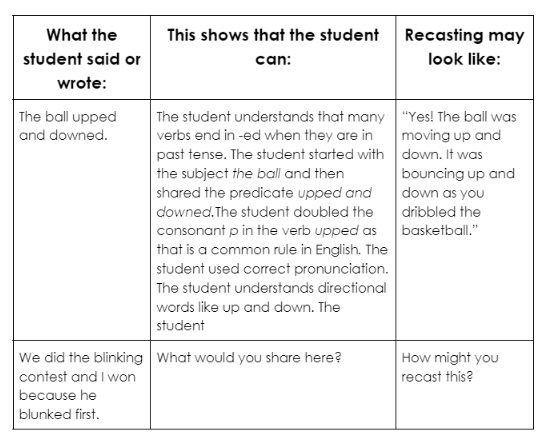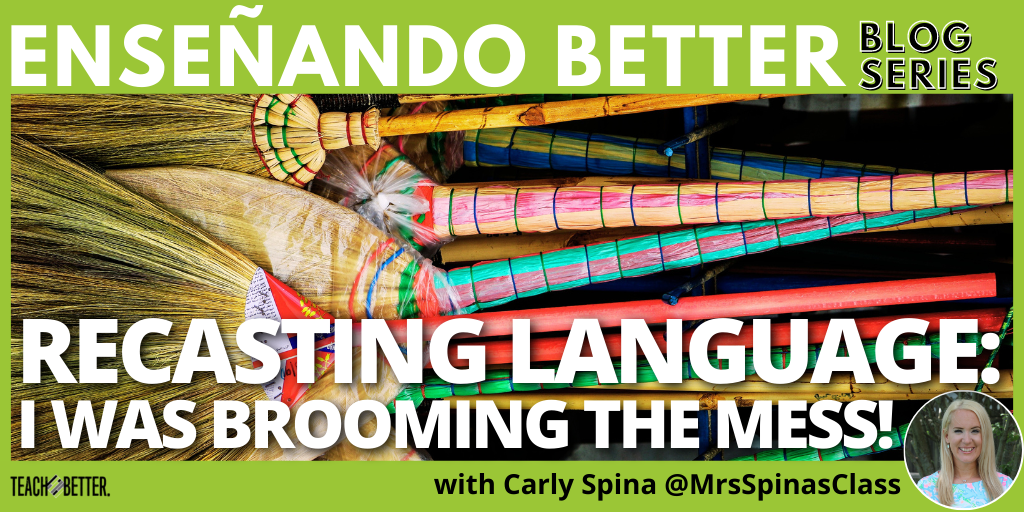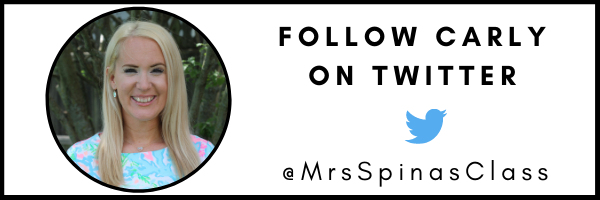TL;DR:
- Celebrate what students are doing in their language development.
- Recast their language by acknowledging the strengths they have while modeling correct usage.
As educators, we are constantly checking in on our students and their progress. We are always looking at ways to support our students in their academic, linguistic, and social-emotional growth. Our brains are almost wired to pinpoint the opportunities for supportive instruction. However, sometimes we need to stop doing that.
You may be thinking, Wait…what? Hear me out.
Recasting is a strategy that can keep the affective filter nice and low while also encouraging language play and exploration. Click To TweetSometimes, in our rush to find moments to teach, we miss out on the moments that our students are simply being. Let’s practice a pause. And not only recognize but also celebrate where they currently are—because there’s a lot to celebrate.
Celebrating Language Development
As students grow in their language development, we understand how important it is to lower the affective filter, embrace and nurture a linguistically inclusive culture, and also encourage linguistic creativity and exploration. Because all students are growing in their language development (whether they are monolingual or multilingual), there’s a great and simple strategy that we can all use to support students: it is called recasting.
Let’s try an example. A student was telling a story about a time when she spilled her cereal all over the floor. She shared that she had to clean it all up. Here’s what she shared: The cereal spilled. I had to get the broom. I was brooming the mess. As educators, we might have a knee-jerk reaction to the word “brooming” and label it as incorrect language usage. However, let’s pause and unpack all the things the student did so well in her statement I was brooming the mess.
The student began her statement with the pronoun I, signifying that it was something that she was doing. She also used I was which demonstrates correct subject/verb agreement. She also recognized that in English, there is a verb pattern of I was ____ing to signify that she was doing something in the past, and she correctly used this verb pattern. Let’s also note that the student correctly identified that she was doing an action TO something else (What was she brooming? The mess!). Finally, let’s celebrate the word brooming. There’s evidence that the student knows what a broom is, what it’s for, and how to use it. She knows that sometimes in English, we can take a noun and turn it into a verb! We VERB things all the time (see what I did there?!)! Let’s celebrate that linguistic exploration and give it a round of applause.
Using Recasting as a Strategy
As an educator, I don’t need to get hung up on every single error a student makes. That would be so frustrating to have my language micromanaged by another person, especially if I was simply trying to share a story. In the example of brooming, I can honor what language the student has supplied. Then, I recast it to the student like this: “Oh wow! You spilled the cereal, you grabbed the broom, and you were sweeping up the mess! You swept with the broom!” This allows the student to feel successful but also supplies her with the word sweeping. It is a much different vibe than saying “Brooming is incorrect. Say sweeping instead.”
Recasting is a strategy that can keep the affective filter nice and low while also encouraging language play and exploration. There may be times where we have to specifically give direct feedback as students are learning and practicing specific pieces of language of course, but when students are simply expressing themselves, it is not necessary (or helpful) to correct every single piece of language that a student produces.
[scroll down to keep reading]Benefit of Recasting
I love recasting because it reminds me of fishing. Spending summer evenings fishing with my dad, my husband, and my kids is something I love. I love watching as my dad gives my kids pointers on how to cast in the perfect spot. As they practice, sometimes they’ll have to reel in their line and recast it back out. This is a part of learning how to fish! It’s no wonder that I love the idea of recasting language. It’s a great way to practice in a low-stakes setting. We don’t need to penalize students for every mistake they make as they learn.
Let’s look at the following examples of statements that students may say. These are sample statements from students in various levels of language proficiency and also different grade levels.

While we support our students in their language growth, there are moments where we have to be explicit to support students’ language development. However, let’s use recasting as a way to honor students’ linguistic exploration and build up a supportive and nurturing environment where it’s safe to make mistakes and celebrate everyone’s language growth!
About Carly Spina
Carly Spina has 15 years of experience in Multilingual Education, including her service as an EL teacher, a third-grade bilingual classroom teacher, and a district-wide Multilingual Instructional Coach. She is currently a multilingual education specialist at the Illinois Resource Center, providing professional learning opportunities and technical assistance support to educators and leaders across the state and beyond. Spina enjoys connecting with other educators and leaders across the country and beyond and is an active member of the multilingual education professional learning community. Her first book, Moving Beyond for Multilingual Learners, was published in November 2021 by EduMatch Publishing and is available on Amazon.




